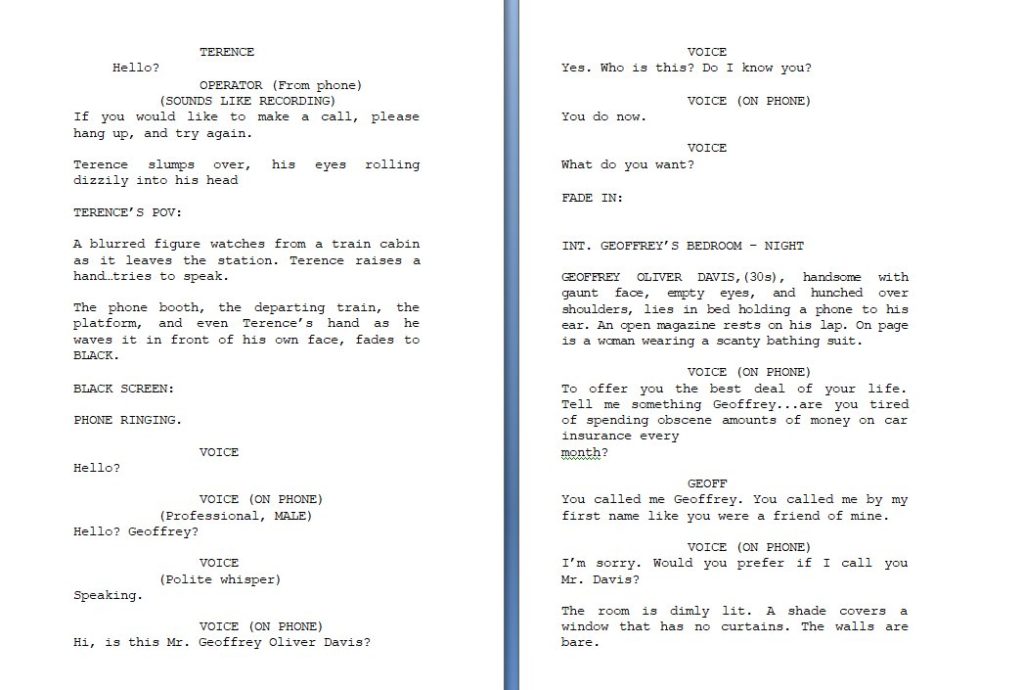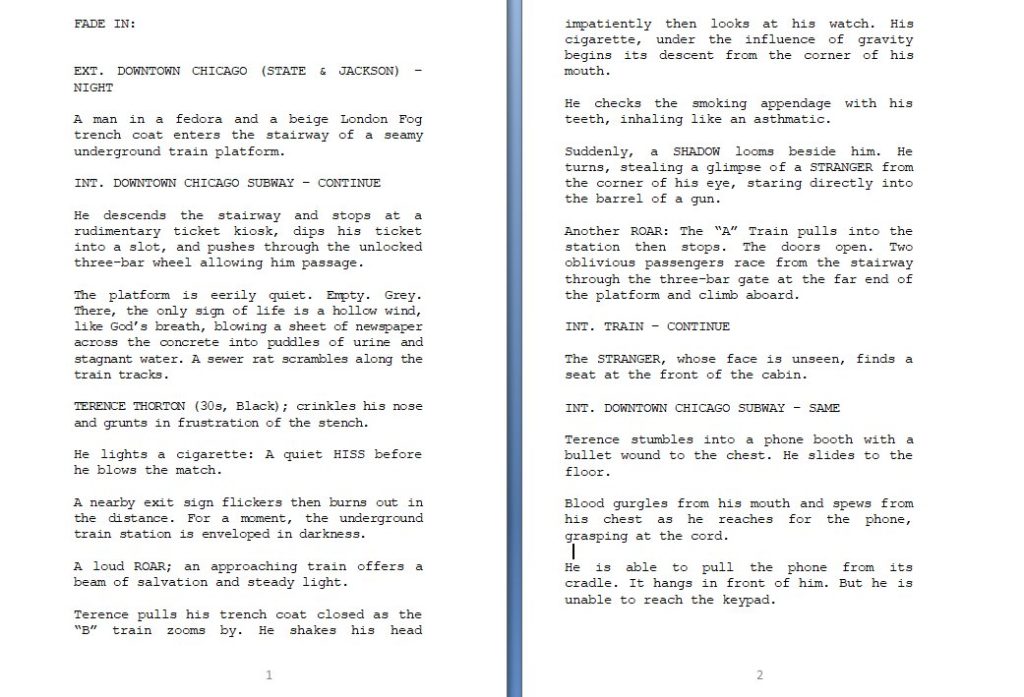Screenwriters write what is called a spec script.
The first step to writing a screenplay is understanding how to format a script. According to the Academy of Nicolls Fellowship (Oscars.org – http://www.oscars.org/nicholl/screenwriting-resources) there is no absolute standard for formatting a screenplay. Most screenwriters prefer to use screenwriting software like Final Draft – an excellent program, or even Celtx. But if you’re like me, and you prefer to format your scripts in a word processing program like Microsoft Word, Word Perfect, or Open Office, follow the steps below.
I would suggest formatting your document before you write. Create a template that you can use more than once.
Font
A screenplay is always written in 12 point Courier or 12 point New Courier font.
Title page
Your title page should have the title of the script and your name. That’s it. Do not include a page number or any other information on your title page.
Margins:
Your left margin must be set to 1.5 from the extreme left side of page.
Tabs:
Your first tab must be set to 1.50 from your left margin. This is where your dialogue begins. In other words, whenever you type a character’s dialogue, your first tab stop at 1.5 from your left margin is where you begin writing dialogue.
Your second tab
2.1 tab stop from your 1.5 left margin position is where you type character instructions or “wrylies”.
Your third tab
2.7 tab stop from your 1.5 left margin. This is where you type your character name whenever the character has spoken dialogue. After typing the character name, “enter” or hard return, and tab over to 1.5 to type your dialogue.
Your fourth tab
Description ends at 6.0
Description begins at the 1.5 margin and ends 6.0
Formatting continued:
- A screenplay is always written in present tense.
- You can only write what can be seen on screen. In other words, you can’t write character thoughts, or inner feelings. You must describe what the viewer sees on screen.
- Page numbers begin on page 2
- A screenplay is between 80 and 120 pages.
- One page should equal 1 minute a screen time.
- Writers and co-writers should appear in this format: John Doe and Jane Doe (if both wrote the script together), or John Doe & Jane Doe (If the second author joined at a later date)
- Always capitalize the character’s name when the character is first introduced in your screenplay.
- Always capitalize character names where dialogue appears.
Definitions:
- Each scene header begins with INT. (interior) or EXT. (exterior). This indicates whether the scene takes place indoors or outdoors. (See example below)
- Wrylie. A wryle is an actor direction. This appears under the character’s name.
- CUT TO (use sparingly). Cut is a direction that appears in a shooting script. It means we have cut to another scene.
- OS means Off Screen. This is written to indicate that an action or dialogue is occuring off screen.
- BLACK SCREEN – means that we see a black screen. FADE IN, means we are fading in at the beginning of a script or movie.
- VO – means Voice Over. This means, we hear a narrator or character’s voice, over actions appearing on screen.
- Your screenplay should be printed on standard paper. Your title page on 25lb cardboard stock paper. Your screenplay should be 3 hole punched. You should use ACCO brand two prong fasteners to bind your script.
- Camera directions are always capitalized. Camera directions should used sparingly, as they are mostly used in the shooting script.
- Capitalize special effects.
Example spec script excerpt:
 EXT. DOWNTOWN CHICAGO (STATE & JACKSON) – NIGHT
EXT. DOWNTOWN CHICAGO (STATE & JACKSON) – NIGHT
A man in a fedora and a beige London Fog trench coat enters the stairway of a seamy underground train platform.
INT. DOWNTOWN CHICAGO SUBWAY – CONTINUE
He descends the stairway and stops at a rudimentary ticket kiosk, dips his ticket into a slot, and pushes through the unlocked three-bar wheel allowing him passage.
The platform is eerily quiet. Empty. Grey. There, the only sign of life is a hollow wind, like God’s breath, blowing a sheet of newspaper across the concrete into puddles of urine and stagnant water. A sewer rat scrambles along the train tracks.
TERENCE THORTON (30s, Black); crinkles his nose and grunts in frustration of the stench.
He lights a cigarette: A quiet HISS before he blows the match.
A nearby exit sign flickers then burns out in the distance. For a moment, the underground train station is enveloped in darkness.
A loud ROAR; an approaching train offers a beam of salvation and steady light.
Terence pulls his trench coat closed as the “B” train zooms by. He shakes his head impatiently then looks at his watch. His cigarette, under the influence of gravity begins its descent from the corner of his mouth.
He checks the smoking appendage with his teeth, inhaling like an asthmatic.
Suddenly, a SHADOW looms beside him. He turns, stealing a glimpse of a STRANGER from the corner of his eye, staring directly into the barrel of a gun.
Another ROAR: The “A” Train pulls into the station then stops. The doors open. Two oblivious passengers race from the stairway through the three-bar gate at the far end of the platform and climb aboard.
INT. TRAIN – CONTINUE
The STRANGER, whose face is unseen, finds a seat at the front of the cabin.
INT. DOWNTOWN CHICAGO SUBWAY – SAME
Terence stumbles into a phone booth with a bullet wound to the chest. He slides to the floor.
Blood gurgles from his mouth and spews from his chest as he reaches for the phone, grasping at the cord.
He is able to pull the phone from its cradle. It hangs in front of him. But he is unable to reach the keypad.
TERENCE
Hello?
OPERATOR (SOUNDS LIKE RECORDING) If you would like to make a call, please hang up, and try again.
Terence slumps over, his eyes rolling dizzily into his head.
TERENCE’S POV:
A blurred figure watches from a train cabin as it leaves the station. Terence raises a hand…tries to speak. The phone booth, the departing train, the platform, and even Terence’s hand as he waves it in front of his own face, fades to BLACK.
BLACK SCREEN:
PHONE RINGING.
VOICE
Hello?
VOICE ON PHONE
(Professional, MALE)
Hello? Geoffrey?
VOICE
(Polite whisper)
Speaking.
VOICE ON PHONE
Hi, is this Mr. Geoffrey Oliver Davis?
VOICE
Yes. Who is this? Do I know you?
VOICE ON PHONE
You do now.
VOICE
What do you want?
FADE IN:
INT. GEOFFREY’S BEDROOM – NIGHT GEOFFREY OLIVER
DAVIS,(30s),handsome with gaunt face, empty eyes, and hunched over shoulders, lies in bed holding a phone to his ear. An open magazine rests on his lap. On page is a woman wearing a scanty bathing suit.

